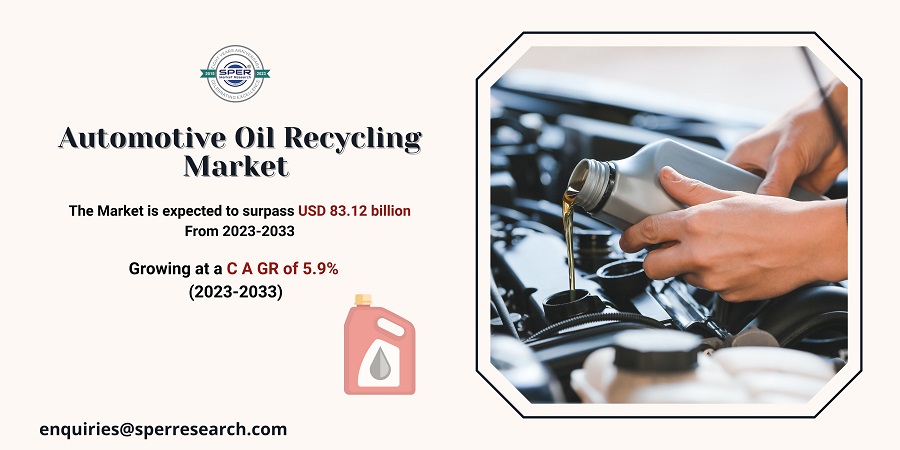Automotive Oil Recycling Market Growth 2023, Global Industry Share, Revenue, CAGR Status, Challenges, Future Opportunities and Forecast Analysis 2033: SPER Market Research

Oil recycling is the systematic restoration of used oil to regain its essential properties for alternative applications. Specifically applied to the automotive sector, automotive oil recycling focuses on the repurposing of used vehicle oil for various industrial uses. The process encompasses diverse methods, with one such technique involving filtration to eliminate solid impurities from the oil.
According to SPER market research, ‘Automotive Oil Recycling Market Size- By Oil Type, By Collection Method, By Technology, By End User Industry, By Distribution Channel- Regional Outlook, Competitive Strategies and Segment Forecast to 2033 state that the Global Automotive Oil Recycling Market is predicted to reach USD 83.12 billion by 2033 with a CAGR of 5.9%.
The automotive oil recycling market is expanding steadily due to the mentioned factors. Repurposing used oil not only safeguards precious resources but also diminishes the energy consumption and emissions tied to manufacturing new lubricants from raw materials. This renders the recycling process an appealing choice for businesses aiming to augment their sustainability endeavors. Furthermore, ongoing advancements in oil re-refining technologies have markedly enhanced the quality of recycled oil. Innovative techniques such as hydro-treating and vacuum distillation have raised the standards of regenerated oil, placing it on par with virgin oil in terms of performance. Positioned at the forefront of sustainable solutions for the automotive industry, the automotive oil recycling market not only addresses environmental concerns but also represents a compelling economic opportunity. With evolving technology and a growing commitment to sustainability, the market is poised for sustained growth and continued innovation.
Despite efforts through public awareness campaigns, a significant portion of consumers remains unaware of the benefits associated with recycling vehicle oil, posing a challenge to the automotive oil recycling market. This lack of awareness may result in improper disposal practices, hindering market growth. Instances of inappropriate disposal, such as spills on the ground or down drains, not only contribute to environmental contamination but also incur additional cleanup costs. Ensuring consistent quality in recycled oil products remains challenging, given variations in used oil feedstock quality and the recycling process. These factors may affect the market acceptance of recycled oils, underscoring the need to address public unawareness and ensure proper disposal practices.
Due to supply chain interruptions and decreased vehicle usage, the COVID-19 epidemic had a major impact on the global automotive oil recycling sector. Car maintenance operations decreased as a result of lockdowns, limitations, and economic uncertainty, which had an effect on the amount of used oil that was generated for recycling. But interest in recycling motor oil has continued to rise due to the increased focus on sustainability and environmental issues, which could lead to a comeback when economies progressively improve.
Request For Free Sample Report @ https://www.sperresearch.com/report-store/automotive-oil-recycling-market.aspx?sample=1
Geographically, North America is anticipated to dominate the automotive oil recycling market in the forecast period due to strict regulations governing the sustainable disposal of used oils. The Asia Pacific market, driven by robust automotive sales and an expanding vehicle parc, is expected to be the second-largest. Europe is projected to witness the fastest growth, credited to elevated awareness and widespread adoption of circular economy practices in the region. Additionally, some of the market key players are CHCC Eagle Environmental Services, Inc., Heritage-Crystal Clean, LLC, MidStates Oil Refining Co. LLC, Texas Used Oil Collection Program, Universal Lubricants, Others.
Automotive Oil Recycling Market Key Segments Covered
The SPER Market Research report seeks to give market dynamics, demand, and supply forecasts for the years up to 2033. This report contains statistics on product type segment growth estimates and forecasts.
By Oil Type: Based on the Oil Type, Global Automotive Oil Recycling Market is segmented as; Brake Fluids, Engine Oils, Gear Oils, Greases, Hydraulic Fluids, Transmission Fluids, Others.
By Collection Method Type: Based on the Collection Method Type, Global Automotive Oil Recycling Market is segmented as; Automotive Manufacturers, DIY Collection Centers, Garages & Service Stations, Independent Collectors, Municipal Collection Centers, Re-Refineries, Others.
By Technology: Based on the Technology, Global Automotive Oil Recycling Market is segmented as; Acid/Caustic Treatment, Clay Treatment, Distillation, Hydroprocessing, Thin Film Evaporation, Vacuum Distillation, Others.
By End-use Industry: Based on the End-use Industry, Global Automotive Oil Recycling Market is segmented as; Automotive, Industrial, Marine, Others.
By Distribution Channel: Based on the Distribution Channel, Global Automotive Oil Recycling Market is segmented as; Direct Sales, Indirect Sales.
By Region: This research also includes data for North America, Asia-Pacific, Latin America, Middle East & Africa and Europe.
For More Information, refer to below link:-
Automotive Oil Recycling Market Outlook
Related Reports:
Follow Us –
LinkedIn | Instagram | Facebook | Twitter
Contact Us:
Sara Lopes, Business Consultant – USA
SPER Market Research
+1-347-460-289974





